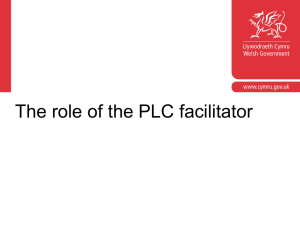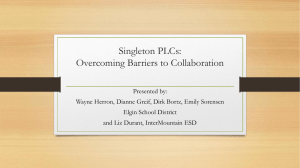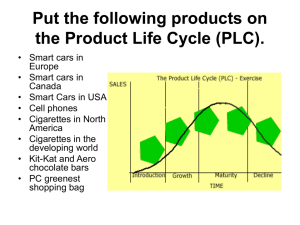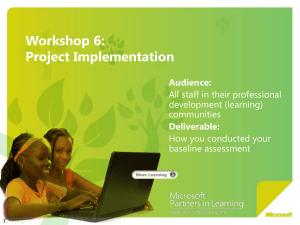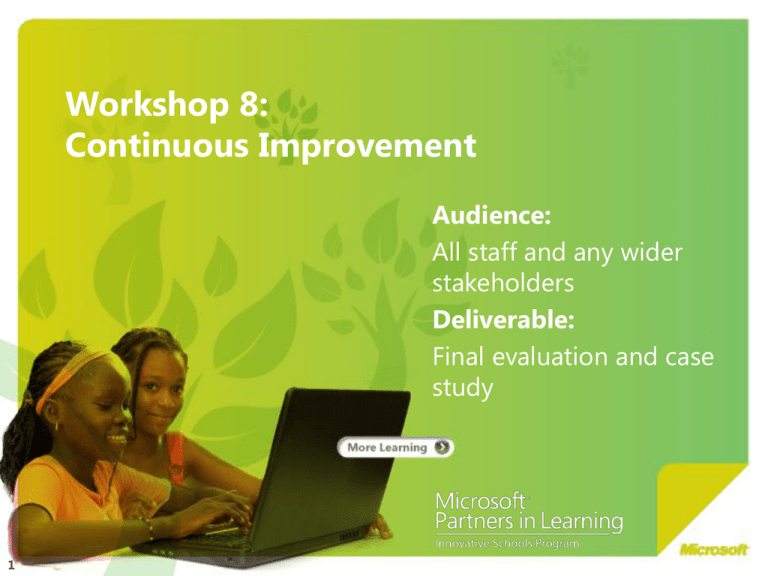
Workshop 8:
Continuous Improvement
Audience:
All staff and any wider
stakeholders
Deliverable:
Final evaluation and case
study
1
Prerequisites for this Workshop
2
•
From the introduction workshop – key features of this workshop such as
the ‘Parts’, ‘Suggested Agenda’ and ‘Overview’ are described in the
introduction to the workshops which is a general guide to the workshop
series.
•
From workshops 2 and 3 – your school’s vision, set out using the REORDER
framework together with the innovation planning documents.
•
From workshop 6 – baseline data taken at the start of each individual
project.
•
Data against which to compare baselines – a copy of the process taken at
workshop 6 but this time at the end of the process to allow comparison and
progression.
Workshop 8 of 8: Continuous
Improvement
• There are eight broad
workshops in the
Innovative Schools
Toolkit.
• Each workshop
provides ideas,
activities, links to
other resources,
strategies and
frameworks.
• Please use the
resources and
PowerPoint called
‘Introduction to the
IST workshop series’
for detailed guidance
on the workshops.
• Consider your local
context to select the
most appropriate
strategies offered in
these workshops.
3
On-going
Continuous
Improvement
Overview
4
•
After a year of effort towards whole school core aims it is essential that the
school collectively evaluates the progress that has been made against the
vision set out at the start of the process.
•
This is an opportunity to share reflections and re-connect with the core
purpose and vision of the school.
•
This workshop provides example analysis and evaluation tools for staff and
will help to structure an event at which collective progress can be evaluated
and recognised.
Guiding Questions
5
•
Over the last year, what event, project
or story best captured the essence of
what the school stands for?
•
What are our objective measures and
subjective measures telling us?
•
How do you improve the ability of all
teachers to be reflective and able to
evaluate what is moving the school
forward?
•
Which projects and successes from
this year will form the basis of our
continuing work next year and which
were just good projects that have
served their purpose?
Progression towards effective evaluation
Level
Description
Ubiquitous – evaluations are authoritative and used widely as guidance by other schools.
9
• The school uses the continuous improvement cycle to refine its central educational philosophy.
• Projects become more diverse and locally owned but the framework that aligns them becomes clearer.
• Capacity for creativity, reflection, collaboration, inquiry, engagement and leadership is continually increased.
Integrated – whole school impact is assessed using data, success stories and opinions
7
5
3
1
6
•
•
•
•
IT systems are used to collect and process data across the whole school including perception data from learners.
Each PLC debates the impact of their projects from data and other sources and impact on school vision and aims.
Successful projects are debated then scaled or improved for next year – these are shared with other schools.
Learners are actively engaged in the evaluation process and recommendations for scaling.
Defined – the school collects outcomes of all projects so they can report on overall impact
• The school evaluates progression towards core aims by combining evaluations of all individual projects.
• Evaluation reports on the number of teachers and students that were engaged overall to drive this higher.
• Evaluation reports on the potential for expansion and alignment with the school vision of each innovation.
Developing - teachers evaluate their projects against their baseline and expected outcomes
• Individuals evaluate success by comparing baseline and expected outcomes of their own projects.
• Each PLC team puts forward a suggestion they feel should be pursued or expanded on next year.
Aware - existing teams evaluate successes anecdotally and focus on some to take further
• Ideas that worked and ones that did not are considered from a largely anecdotal perspective.
• Evaluations are done at team or department level. Impact on the larger vision is not assessed.
Suggested Agenda for the workshop
Aims
Suggested Approaches
Resources
Part 1 Build Individual and
group capacity for
evaluation
1.
Templates for self and group
evaluation
Part 2 Hear success stories
and consider what has
been learnt.
3.
Part 3 Create coherence
and decide on the key
success stories of the year
Final deliverable – case
studies
7
Pre-preparation – all staff do a personal
evaluation and then one in their PLC teams.
Case study presentation
template
Presentations – all the best projects chosen by
PLCs
Each PLC give a 5 minute presentation and then take
questions.
4.
Discussion – which projects can and should
scale?
5.
Presentation – reflection from the senior
team.
Presentations prepared by
each PLC
Post-its and printed guide
questions
Year highlights to illustrate the vision in action
Copies of the REORDER
vision and key documents
from the year are likely to be
found useful
6.
Discussion – the match between vision and
practice
Teams will be writing so
require flip paper and pens
7.
Discussion - expected and unexpected gains
8.
Conclusions – lessons learnt, progress made
What are the big headlines and big surprises?
How do we document success, extend audiences for
our work, engage more stakeholders and build on
successes?
Final Evaluation Case Study
template
Part 1. Build individual and group capacity
for evaluation
8
•
In preparation for the final workshop you should first reach your own
conclusions about what was successful this year, then meet in your PLC to
present your conclusions.
•
Members of each PLC will then debate each others’ evaluations and draw up
a set of recommendations and findings that will be presented at the
workshop.
•
This section is to help you and your PLC compile this presentation.
Questions for each teacher (researcher)
For each of the projects you have done this year:
•
•
•
•
•
•
•
•
•
•
Did you enjoy doing the project?
Do you think the learners enjoyed the project?
Which of the school’s core aims were you attempting to improve?
What was the baseline measurement you took before you started?
When you repeated this measurement at the end, what improvements were
there?
Were the improvements in line with what you expected?
How would you do the project differently next time?
Would you recommend this project to other teachers?
What would be the one piece of advice you would give to other teachers?
Could your project be scaled to other schools in other countries?
Look at the school vision document – can your project be used as an example to other schools of how the
vision in your school is moving forward?
9
Presenting to your PLC
Prepare a short five minute presentation to your PLC team
•
•
•
•
•
10
Use the questions on the previous slide to go through each project you have
done this year.
Which project is the best one to carry forward into next year?
How should it be carried forward:
• By you, extending it to other classes or improving it
• By teachers that you will work with and support
• By teachers in the school working just from your case study
• By teachers in other schools working towards similar goals.
What evidence do you have that it has improved outcomes in the core aims for
learners?
Can the project scale to become a whole school initiative? What work would need
to be done? If it was already part of a whole school ‘project’ how can your
contribution inform the whole school direction next year?
Suggested agenda for your PLC meeting
Minutes Suggested agenda item
11
5
1.
Teacher / researcher #1 [name] presents their findings from the year to the
PLC team
5
2.
Hot seat discussion - the other members of the group ask questions to check
understanding and the details of the project. The teacher supports their evidence.
5
3.
Teacher / researcher #2 [name] presents
5
4.
Hot seat discussion
5
5.
Teacher / researcher #3 [name] presents
5
6.
Hot seat discussion
5
7.
Teacher / researcher #4 [name] presents
5
8.
Hot seat discussion
10
9.
Conclusions – which project should go forward to the whole school meeting?
Debate the relative merits of each project, the strength of the evidence and the
impact on the core aims and vision of the school. Which would be most beneficial
for other teachers to replicate next year?
10
10. Preparation – either in the meeting or by dividing tasks between members,
decide what will be presented on behalf of the group at the whole staff meeting.
Suggested ‘hot seat’ questions
1. Which core aims from the school vision does it address?
2. What evidence do you have that it improved outcomes for learners?
3. Why do you believe that the project would raise outcomes in the same way
if it was carried out by other teachers?
4. Name another teacher in this school that could use your findings next year
to also improve outcomes as you have done? What extra information or
support would they need?
5. If every teacher in the school repeated a project along the same lines would
the overall school vision be accelerated forward? Should we suggest this?
12
Example presentation
13
•
The following slides provide a template that can be used by the team to
produce their presentation at the whole staff meeting.
•
The template has been filled in with a real example so it is easier to see how
it works.
•
The example chosen should be deleted from the template and replaced by
your group’s own answers. A blank version of the template is provided for
this purpose afterwards.
•
Please remember you will only have five minutes to make your presentation
so select which items you will speak about in more depth.
Project ‘Wake and Shake’: Before
A project to help the following whole school core aim:
‘Improving the responsibility and leadership skills of all
learners’.
The basic idea:
•
•
•
•
Each week a team of four learners become the ‘Wake and Shake
team’ and organise five minutes of exercise for the whole group.
The team self organise to decide on the exercise and ensure they
have everything they need to be successful.
At the end of the week the class rate the service, how well it was
organised and led and how many times they got 100%
participation from the class.
This provides all learners with an opportunity to lead and take
on a real responsibility.
How the baseline was measured:
•
A questionnaire asked what experience of leadership each learner had, how important
leadership was and they assessed their current skills against the PbyP framework.
Expected impact:
•
14
I predicted that the project would be seen as a genuine leadership opportunity and their
view of the importance of leadership skills will increase.
Project Wake and Shake: After
Opinions and perceptions before and after (selected results)
Indicator
Before
After
Impact
Using PbyP scales how would you rate your leadership
skills?
3.2
4.1
A 30% improvement
On a scale of 1-5 how important are leadership skills to
you?
4.2
4.3
Only minor increase
Would you recommend this project to others?
90%
Very popular approach
Do you feel this project improved your leadership skills
60%
Could be improved
Measured improvements before and after (Selected results)
Indicator
Before
After
Impact
The average PbyP leadership qualification level
1.2
3.4
Closer to self-assessment
Number of learners achieving a level 4 leadership
certificate
2
21
Considerable increase
14
Selected examples shown in
the report
Number of pieces of evidence uploaded to e-portfolios
that were tagged as being inspired by this project
15
Project ‘Wake and Shake’: Expansion
Does the evidence demonstrate improvements to core aims?
Yes, strong evidence – it was effective in improving the core aim of ‘improving the
responsibility and leadership skills of all learners’ and should be repeated. It is recognised
by learners as a real and valued experience that improves the school’s core aims and also
contributes towards the core aim of ‘respect’.
How widely could it scale – what are the limiting factors?
Space is a limiting factor – this would need to be one of many opportunities as the
outside covered space could only support half of the registration groups.
Was this successful just because of your passion for the project and your
ownership? What challenges would others need to face?
Trust from the learners was key. Perhaps it could only be offered initially to those with a
level 4 leadership certificate until the trust built up.
What surprised you most?
Learners’ views on the importance of leadership was really high and they were able to
employ the skills of others in the class much more than I thought previously.
16
Project [‘Project Title’]: Before
A project to help the following whole
school core aim:
[‘The whole school core aim that was the focus of the
project’]
The basic idea:
[Outline description of the project]
How the baseline was measured
[The method for capturing the baseline (not the actual
measurements)]
Expected impact:
[What were your predicted results]
17
Suitable
Image
Project [‘Project Title’]: After
Opinions and perceptions before and after (selected results)
Indicator
Before
After
Impact
Measured improvements before and after (Selected results)
Indicator
18
Before
After
Impact
Project [‘Project Title’]: Expansion
Does the evidence demonstrate improvements to Core Aims?
[Be careful to use actual evidence from the previous slide over your own perception]
How widely could it scale – what are the limiting factors?
[Ask for support from the PLC for this question]
Was this successful just because of your passion for the project and your
ownership? What challenges would others need to face?
[Ask for support from the PLC for this question]
What surprised you most?
[Important to explain that learning is not linear and even with the best planning, the
surprises can be the most interesting part]
19
End of Part 1. Presentation prepared
20
•
As a result of this section you have a completed case study that is ready to
present to the whole school.
•
The case study is either the best example voted by all of the PLC team
members having discussed each others’ work, or it is a combination of the
learning from all the projects developed by the group over the year.
•
Remember that your presentation is focussed on; ‘what should be expanded
on next year to further move the school towards its vision’, so excellent
projects that do not answer this question may not be the ones you choose
to represent your group.
•
The link to the core aim and vision is vital as is the objective evidence of
success.
Part 2. Hear success stories and consider
what has been learnt
21
•
The event is split into three sections; one for each core aim.
•
In each section, each PLC has 5 minutes to give their prepared core aim
presentation as a team, followed by five minutes of questioning.
•
The question, ‘have we been effective in making progress towards this core
aim’ is debated using just this array of opinion and successful projects.
•
At the end of this section, progression in all three core aims will have been
debated.
Some questions about scalability and growth to
consider while listening to presentations
1. Which projects do not resonate very well with you
personally and you could not imagine adopting?
2. Which projects do you understand the purpose and
value of but do not feel able to put into practice
yourself?
3. Which would you personally feel confident to
implement?
4. Which projects can you imagine becoming part of
everyday procedures and practice to improve the
school?
2. Understanding
3. First implementation
4. Routine
5. Which projects are really good ideas that are likely to
spread this year but have potential to be improved
again and again?
5. Refinement
6. Which is the most likely to spread to other schools in
the long term?
6. Replication
7. What features of innovations make them more likely
to be widely implemented rather than be single
projects?
22
1. Awareness
End of Part 2. Final Evaluation
Case Study
Use the final innovation case study template provided to help you complete an
evaluation of your school’s key innovations
23
Part 3. Create coherence and decide on the
key success stories of the year
24
•
A collection of excellent projects does not necessarily create a coherent
whole school ethos, philosophy and direction.
•
This section brings together all of the success stories and the whole school
vision to re-imagine where the findings could take us.
•
Whole school surveys and data are also presented here if available so that
the mission and success of the school can be evaluated.
1. Report from the Headteacher/principal
A review of the year from the perspective of the headteacher /principal and
senior leaders:
•
Other results such as examination success
•
Indictors and trends
•
Surveys and reports
•
Visits and external perceptions
•
Reminders of press releases and events during the year
•
Moments in the year that captured the ethos
•
Stories that illustrate direction.
25
2. Revisit the REORDER vision of the school
Provide copies of the reorder vision and allow time to discuss the following
points:
a) Share examples of when the vision statement came alive during the year –
what single event exemplified it for you?
b) We have discussed the core aims in some depth as separate aims – what was
in the space in the middle? When did they work together in the year to great
effect?
c) Have we missed anything in terms of the work we need to do on
relationships, environments etc (REORDER)?
d) What were the biggest surprises from the year?
26
3. Strengthening the philosophy
In your groups describe the one story, project, event or outcome this year that
is the single best description of:
1. The nature of the learners, teachers and other stakeholders that make up
this community. Qualities which we are both drawing from and building
upon.
2. The direction the school is heading in, its ambition and philosophy.
Agree on the best of each and write a brief description with a name of someone
who could explain it further on a Post-it.
27
4. Moving forward
In your groups discuss:
28
•
How does all this work combine?
•
Is there a bigger step or larger change that should be happening and which
the school is ready for?
•
Which projects and events from this year are the ones showing the direction
for next year?
•
What should we stop doing to make space for new work?
•
What did we get right and wrong this year and what would be three
recommendations from the group for next year?
End of Part 3. Preparing to restart the cycle
29
•
At the end of this session, clear success stories and significant events that
have moved the school forward have been shared.
•
The continuous improvement cycle is most effective if all of these key
learning points are celebrated, recognised and documented so that they
form solid building blocks for re-starting the cycle.
•
The conclusions from the year must be based on a rich mixture of objective
data, emotions, passions and aspirations. Capturing all this is the goal of this
final workshop and the requirement of the next cycle.
© 2011 Microsoft Corporation. All rights reserved. Microsoft, Windows, Windows Vista and other product names are or may be registered trademarks and/or trademarks in the U.S. and/or other countries.
The information herein is for informational purposes only and represents the current view of Microsoft Corporation as of the date of this presentation. Because Microsoft must respond to changing market
conditions, it should not be interpreted to be a commitment on the part of Microsoft, and Microsoft cannot guarantee the accuracy of any information provided after the date of this presentation.
MICROSOFT MAKES NO WARRANTIES, EXPRESS, IMPLIED, OR STATUTORY, AS TO THE INFORMATION IN THIS PRESENTATION.
30



